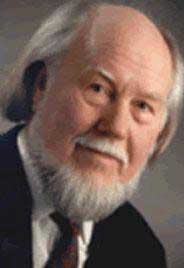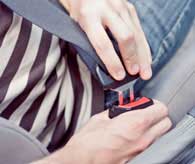SHIRLEY GRIFFITH:
This is SCIENCE IN THE NEWS in VOA Special English. I'm Shirley Griffith.
BOB DOUGHTY:
And I'm Bob Doughty. Today we tell about two recent inventions that have helped to save lives. We will also tell about the people who developed them.
(MUSIC)
SHIRLEY GRIFFITH:
Most cars have seat belts as part of their equipment. Seat belts protect drivers and passengers in case of accident. They also reduce the effect of a crash on the body. Safety experts estimate that the restraining devices save more than 4,000 lives a year in the United States alone. Worldwide, some experts, say the devices have protected up to a million people.

The first seat belt was said to have been created in the 1800s by George Cayley of England. He is remembered for many inventions, especially for early "flying machines."
The United States first recognized the invention of an automobile seat belt in 1849. The government gave a patent to Edward J. Claghorn of New York City so that others would not copy his invention. Claghorn called the device a Safety-Belt. It was said to include hooks and other attachments for securing the person to a fixed object.
BOB DOUGHTY:
Other inventors followed with different versions of the seat belt. But more than 100 years passed before the current, widely used seat belt was developed. It resulted from the work of a Swedish engineer, Nils Bohlin. His three-point, lap and shoulder seat belt first appeared on cars in Europe 50 years ago.
Bohlin was born in Sweden in 1920. After completing college, he designed seats for the Swedish aircraft industry. The seats were built for the pilot to escape from an airplane in case of disaster. Bohlin's work with planes showed him what could happen in a crash at high speed. In 1958, Bohlin brought that knowledge to the Swedish car manufacturer Volvo. He was the company's first chief safety engineer.
At the time, most safety belts in cars crossed the body over the abdomen. A buckle held the restraints in place. But the position of the buckle often caused severe injuries in bad crashes.

SHIRLEY GRIFFITH:
Nils Bohlin recognized that both the upper and lower body needed to be held securely in place. His invention contained a cloth strap that was placed across the chest and another strap across the hips. The design joined the straps next to the hip.
Volvo was the first automobile manufacturer to offer the modern seat belt as a permanent addition to its cars. It also provided use of Nils Bohlin's design to other car-makers.
The Swedish engineer won many honors for his seat belt. He received a gold medal from the Royal Swedish Academy of Engineering Sciences in 1995. He died in Sweden in 2002.
(MUSIC)
BOB DOUGHTY:
Kevlar is another invention that has saved many people from serious injury and death. Kevlar is a fibrous material with qualities that make it able to reject bullets. Added to clothing, the material protects security officers and soldiers across the world.
The fibers form a protective barrier against gunfire. Bullets lose their shape when they strike Kevlar. Those bullets look like mushrooms, and do not enter the body. Most threats to police and security officers come from handguns. They wear Kevlar vests to protect the upper body. Soldiers wear more extensive clothing protected with Kevlar against heavier ammunition.
SHIRLEY GRIFFITH:
Kevlar might not have been invented had Stephanie Kwolek been able to seek a career in medicine. From childhood, she wanted to be a doctor. But she lacked the money for a medical education.
Today, thousands of people are glad that Stephanie Kwolek became a research chemist. In that job, she developed the first liquid crystal polymer. The polymer was a chemical product that formed the basis for Kevlar.

BOB DOUGHTY:
Stephanie Kwolek was born in 1923 in New Kensington, Pennsylvania. As a child, Stephanie loved science. Later, she studied chemistry and other sciences at a Pennsylvania college now known as Carnegie Mellon University.
She got a job with the DuPont chemical company in 1946. It was the beginning of a career with the company that lasted about 40 years.
SHIRLEY GRIFFITH:
By the 1960s, Dupont already had produced materials like nylon and Dacron. The company wanted to develop a new fiber. Stephanie Kwolek was part of a DuPont research group that asked to work on its development.
At the time, she was searching for a way to make a material strong enough to use on automobile tires. If tires could be improved, automobiles would need less fuel. Miz Kwolek needed a new way to make stiff, resistant fibers for the job.
BOB DOUGHTY:
Her experiments for the project were supposed to produce a clear substance similar to a thick syrup. Instead, what Stephanie Kwolek produced was unexpected. It was a liquid that looked cloudy or milky. She said she might have thrown it out. But she decided to let it sit for awhile.
Recently, she told VOA that she was warned the liquid could never complete a required process. The process calls for the chemical to be pushed through the small holes of a spinneret. She remembers that the man operating the device at first refused to accept her material. He probably suspected it had solid particles that would block the holes. However, after a while he said he would try it. She says she thinks he was tired of being asked, or might have felt sorry for her.
SHIRLEY GRIFFITH:
That person must have been surprised when the substance passed the test. It returned from the laboratory with more firmness than anything Stephanie Kwolek had made before.
Mizz Kwolek did not tell anyone that she had produced something new and strong. She said she was afraid there might have been a mistake. Repeated testing, however, did not find anything wrong. She and her group worked to improve the discovery. DuPont first manufactured large amounts of Kevlar in 1971. The material is found today in hundreds of products from sports equipment to window coverings.
Over the years, Stephanie Kwolek has received many awards. Her honors include membership in the National Inventors Hall of Fame. Today she says she loved her long career in chemistry. She says that considering the times, she was lucky to get the job.
(MUSIC)
BOB DOUGHTY:
Getting Kevlar placed in protective clothing resulted mainly from the work of Lester Shubin and Nicholas Montanarelli. Mr. Shubin was educated in chemistry. He worked for the United States Army in the 1970s. At the time, Mr. Montanarelli was an Army project director. He was trained in engineering and psychology.
The two Americans were working at the Aberdeen Proving Ground in Maryland. They were searching for a way to protect people in public life from gunfire. Mr. Montanarelli knew about DuPont's recently developed fiber, and the two men decided to test it.
SHIRLEY GRIFFITH:
The men fired handguns at several materials protected by Kevlar. The material changed the shape of the bullets. It seemed a good candidate to help defend police officers and soldiers.
Mr. Shubin was able to gain financial help for a field experiment. Thousands of police officers in many cities began to wear the vests. But Mr. Montanarelli said it was difficult to get companies to make them. The companies feared legal action if the vests should fail.
BOB DOUGHTY:
Then came December, 1975. A gunman shot at a policeman in Seattle, Washington. One bullet hit the officer's hand. But a bullet fired very close to the policeman struck his chest.
The officer survived. The bullet did not enter his body. He felt good enough to protest being kept in a hospital that night to make sure all was well. The incident helped get manufacturers to stop worrying about legal action. They began making the vests.
SHIRLEY GRIFFITH:
Today, about 3,000 people are members of the Kevlar Survivors' Club. DuPont and the International Association of Chiefs of Police organized the exclusive club. All the members have escaped injury or death because long ago, a chemist named Stephanie Kwolek produced something unexpected.
BOB DOUGHTY:
This SCIENCE IN THE NEWS was written by Jerilyn Watson. Our producer was Brianna Blake. I'm Bob Doughty.
SHIRLEY GRIFFITH:
And, I'm Shirley Griffith. Join us again next week for more news about science in Special English on the Voice of America.
Kevlar: the registered trademark for a light, strong para-aramid synthetic fiber 凯芙拉
polymer: a natural or artificial compound consisting of large molecules that are made from combinations of small simple molecules 聚合物;聚合体
Dacron: (trademark) used for a synthetic polyester textile fiber 涤纶(一种合成聚酯纤维及其织成的衣料)
spinneret: a multi-pored device through which a plastic polymer melt is extruded to form fibers 喷丝头
In consumer electronics, 3-D and all things wireless
How Earth is cracked like a giant eggshell
Time -- one of the great mysteries of our universe
In Egypt, King Tut's tomb getting a makeover
(来源:VOA 编辑:陈丹妮)
